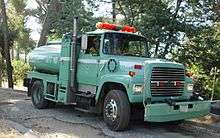Wildland water tender
A wildland fire tender is a specialized vehicle capable of bringing water, foam, or dry chemicals to fire trucks in the field that are engaged on the fireline. These vehicles are specifically designed for fire fighting often with four-wheel drive, rugged suspension and high wheel clearance for mountainous dirt road conditions. According to the National Fire Protection Association, if the apparatus will be used primarily for outdoor and wildland responses, then it is to be considered a wildland fire apparatus and must conform to NFPA 1906.[1]

Fire tenders are generally equipped with associated fire station equipment including required number of breathing apparatus, first aid kits, telescopic ladders, heat-resisting fiberglass blankets, overall suits, electrically insulated rubber hand gloves, fireman's axes with insulated handle, fireman's helmets made of fiberglass, leather belt and pouch for axe, etc.
Often the technique of pump-and-roll is used where the vehicle drives with the pump engaged while a firefighter uses a hose to spray water on the fire. This technique allows a team of two to flank the perimeter of a fire.[2]
Water Tender Types
In the fall of 2007, the National Wildfire Coordinating Group agreed on a set of standards for all water tenders that are used for wildland firefighting. The tenders are divided into support tenders and tactical tenders.[3]
| Tender Type | |||||
|---|---|---|---|---|---|
| Support | Tactical | ||||
| Requirements | S1 | S2 | S3 | T1 | T2 |
| Tank capacity | 4,000 US gal (15,000 l) | 2,500 US gal (9,500 l) | 1,000 US gal (3,800 l) | 2,000 US gal (7,600 l) | 1,000 US gal (3,800 l) |
| Minimum flow rate | 300 US gal/min (68 m3/h) | 200 US gal/min (45 m3/h) | 200 US gal/min (45 m3/h) | 250 US gal/min (57 m3/h) | 250 US gal/min (57 m3/h) |
| Minimum pressure | 50 psi (340 kPa) | 50 psi (340 kPa) | 50 psi (340 kPa) | 150 psi (1,000 kPa) | 150 psi (1,000 kPa) |
| Pump and Roll | |||||
NFPA 1906
Additionally, there are requirements laid out by the National Fire Protection Association in NFPA 1906: Standard for Wildland Fire Apparatus.[4] Some of the many details of the NFPA 1906 include:[1]
- Stability: All wildland apparatus must pass a 30° stability test.
- Roadability: Vehicles must be capable of operating on 20% grades and remain stationary on 10% grades.
- Carrying Capacity: The Standard lays out a detailed analysis of what the allowable additional weight is on top of the gross vehicle weight rating. This is critical to keep the vehicles from getting overweight.
- Pump-And-Roll: Vehicles must be able to deliver 20 GPM at 80 psi while moving at a speed of 2 mph
References
- David, Haston. "NFPA 1906 and Wildland Apparatus Design" (PDF). US Forest Service. Retrieved 6 January 2014.
- Fire Fighter Training, S-130. NWCG. 2003.
- "Engine Types" (PDF). National Wildfire Coordinating Group. Retrieved 5 January 2014.
- NFPA 1906: Standard for Wildland Fire Apparatus (2012 ed.), National Fire Protection Association